Abstract
Recent field works have shown a great potential of rock art in western Iran, particularly in Kermanshah province. This paper has been prepared based on recent fieldwork, which has resulted in identifying new clusters of petroglyphs at the western part of Kermanshah province. Several rock art sites have been identified in Bi-Ravas, Havar Poinrhis in north of Paveh, the rock art to the west of Paveh and the petroglyphs of Ryjab or Ryjav village. The depictions include anthropomorphs, zoomorphs, geometric forms and cupules. A remarkable characteristic of the rock art in the region is the considerable number of cupules, which were identified in Bi-Ravas, North of Paveh and Ryjab village. Only one specimen of a purported hunting scene has been recognized in Biravas, where a primary chronology could be made with regard to the depiction of a horse-like animal, which has been illustrated with a harness. More fieldwork will be required in order to shed more light on the rock art of western Kermanshah.
1. Introduction
Kermanshah province is located in the west of Iran and central Zagros region (Figure 1). Archaeological studies suggest that at least from the Late Lower Paleolithic period (about 300 thousand years ago), human beings have lived in the region of Kermanshah. The founding of this period includes several stone hand axes and cleaver tools found around Gakia and west of Harsin [1].
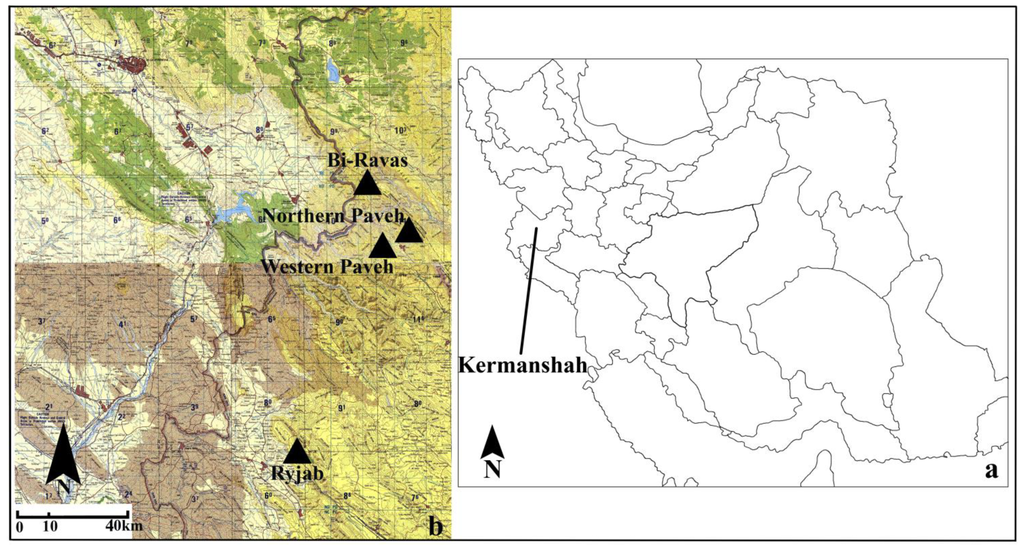
Figure 1.
(a) Map showing the location of Kermanshah province in western Iran; (b) Map showing location of sites in Kermanshah province.
There are two rock art regions reported in the north and north ast of Kermanshah: The pictograms of Marav Za cave in Cheshmeh Sohrab [2,3] and the petroglyphs at the Maiwaleh Mountain [4]. Given the abundance and diversity of rock art in Kurdistan (the northern adjacent province to Kermanshah) that were found during recent years [5,6] and also following other studies to identify rock art in the west of Iran from 2005, our study was extended to the provinces of Kermanshah. During the investigation, the west of the province was studied at different times, because I believed that this area (due to its geography and history) would contain many rock art sites. So, fieldwork focused on the identification of petroglyphs in western Kermanshah.
2. Description of the Petroglyphs
2.1. The Rock Art of Bi-Ravas Village
Hawrāmān is a vast mountainous region between the provinces of Kurdistan and Kermanshah in Iran and Kurdistan Province in Iraq [7], and its people have the same culture. Bi-Ravas village is located at about 160 km to the northwest of Kermanshah and also the zero point of Hooraman in Kurdistan of Iraq. At a distance of 300 m from the northeast of the village, petroglyphs and a considerable number of cupules, have been identified on a rock surface (Figure 2). The image of anthropomorphs supposedly hunting ibexes using bow and arrow (Figure 3 and Figure 4) as well as a geometric form is found (Figure 5). In this place, there is also the picture of a “horse with harness”, which seems to be younger than other designs and cupules (Figure 6). This depiction probably cannot be older than the second millennium BCE, when Aryan immigrants brought horses to the Iranian plateau for the first time [8].
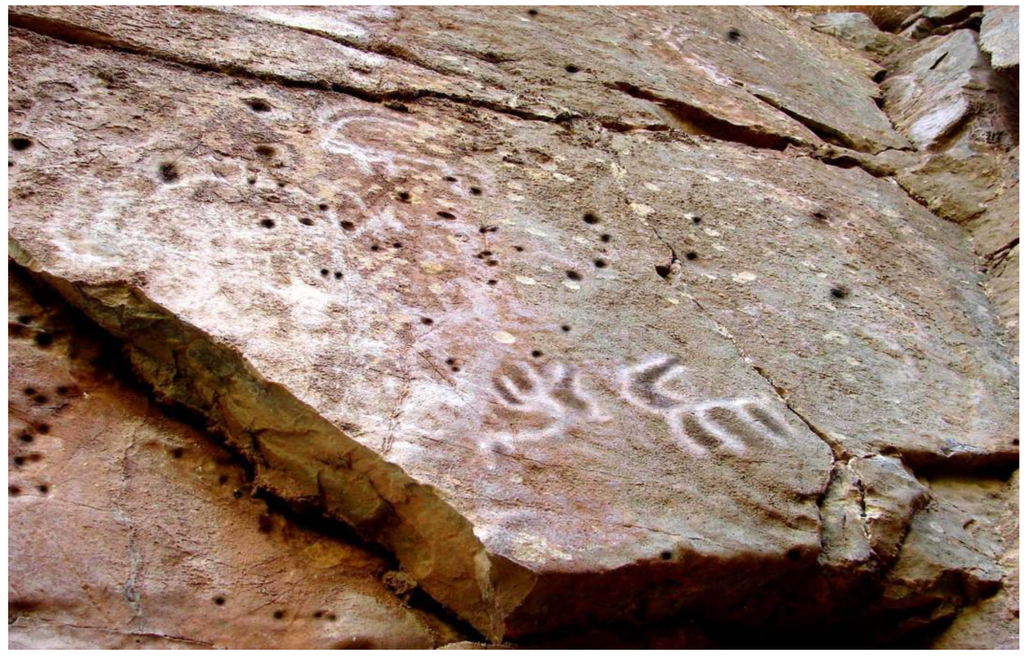
Figure 2.
Images of horned animals and cupules on the vertical surface of Bi-Ravascliff at a height of 5 m.
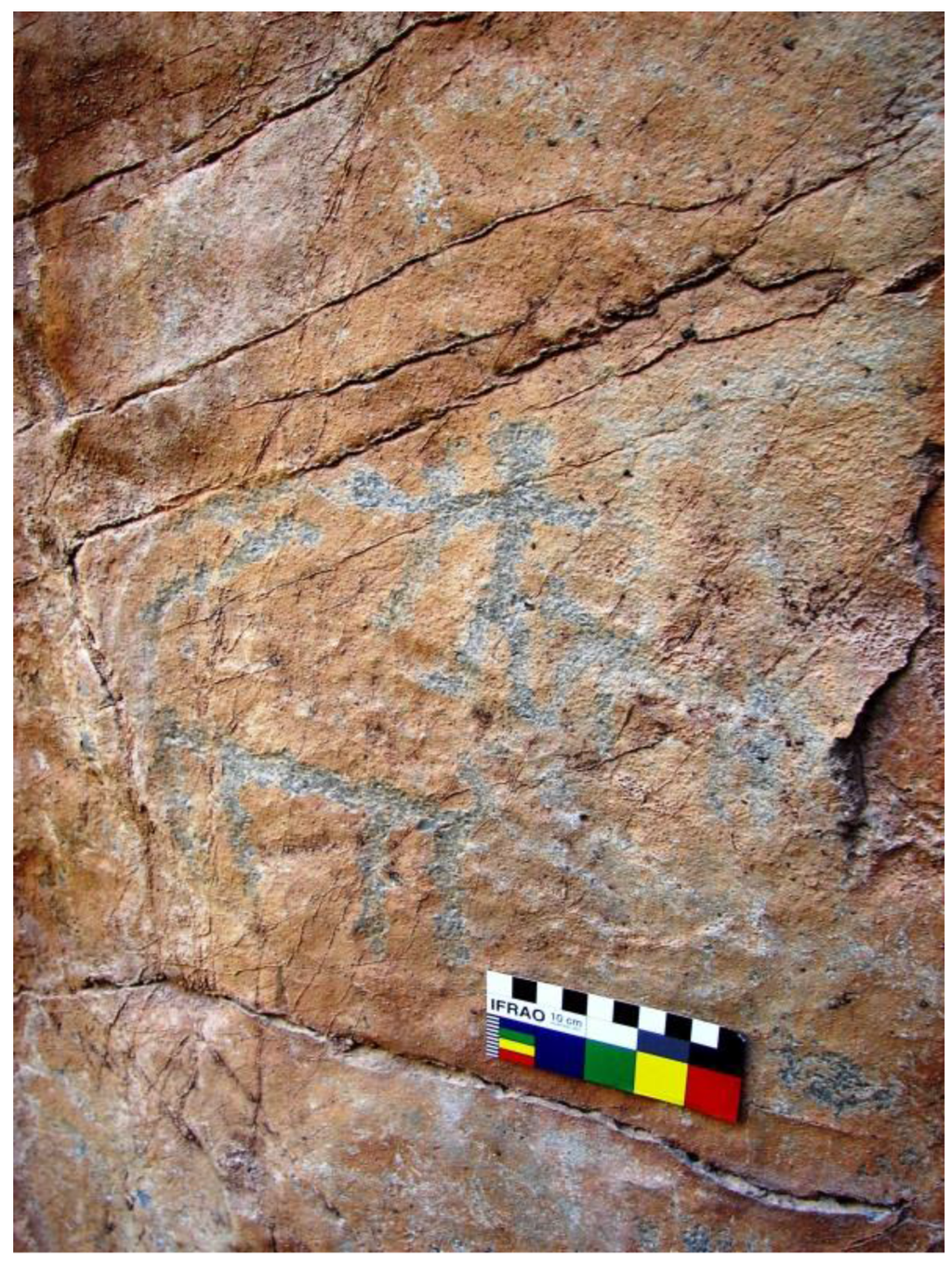
Figure 3.
A possible hunting scene showing zoomorphs and an anthropomorph with “bow and arrow”.
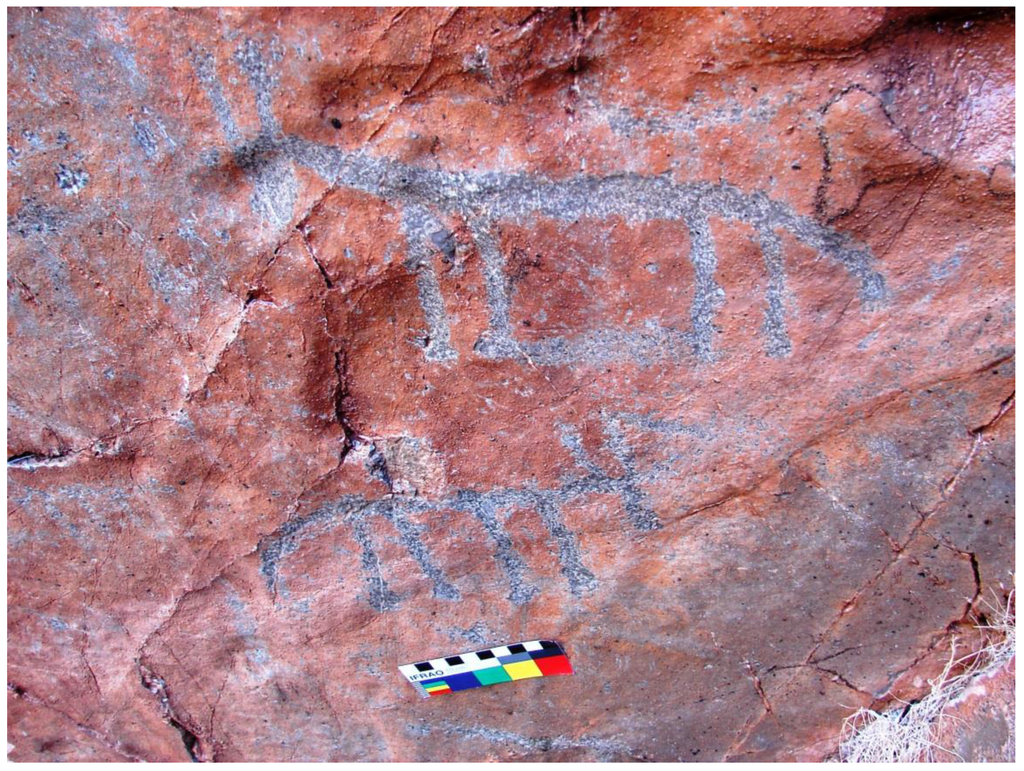
Figure 4.
Depiction of zoomorphs with short “horns”.
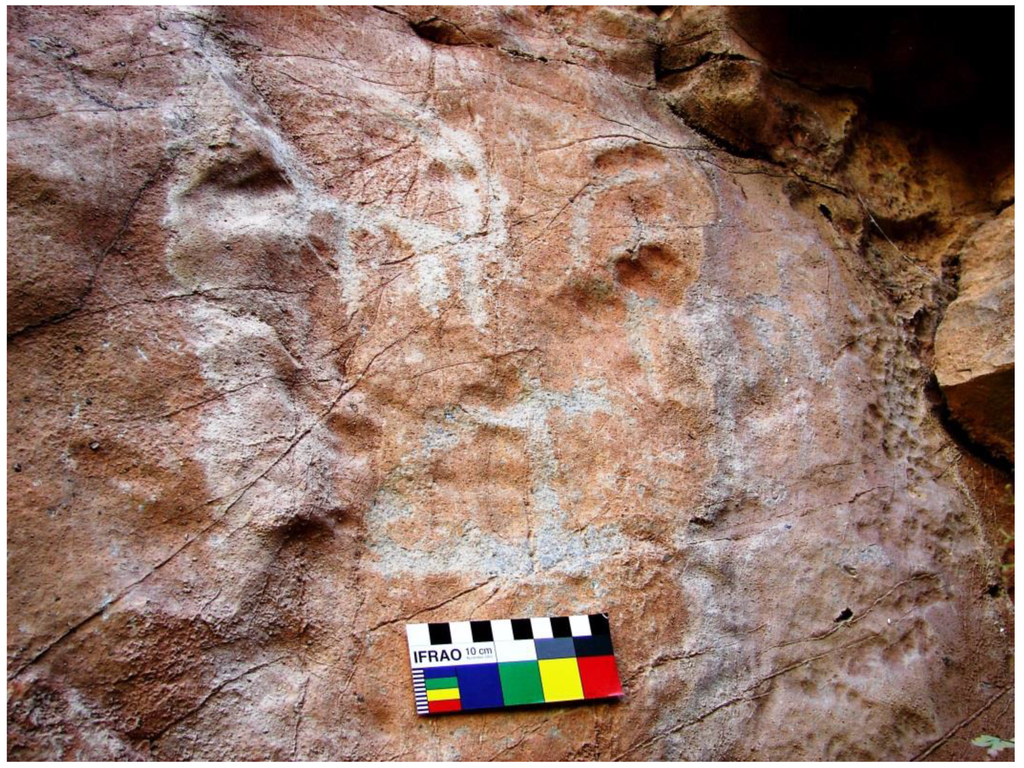
Figure 5.
The Images of zoomorphs and an oval-resembling symbol divided into two parts.
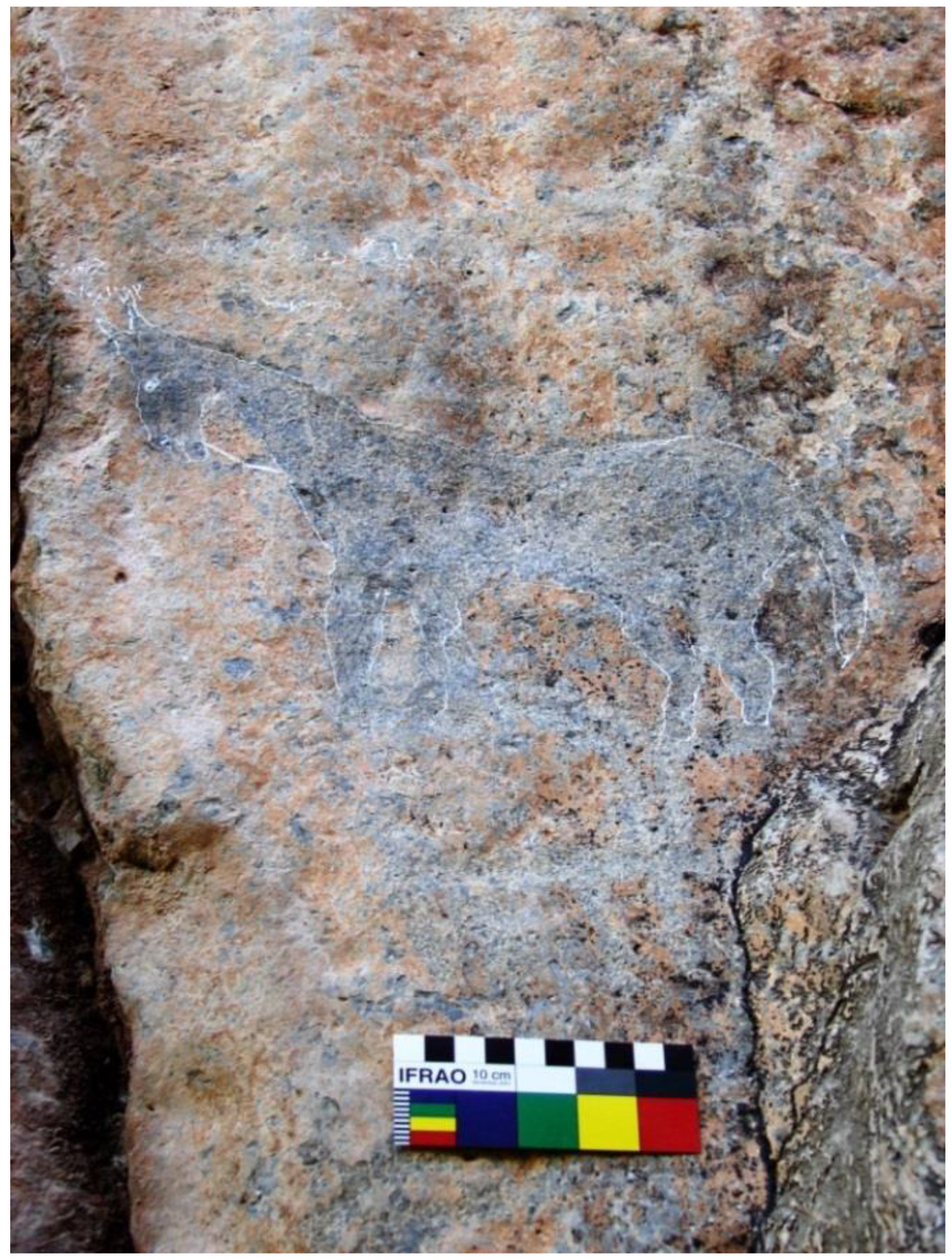
Figure 6.
The image of an “ibex” and a “horse with harness” in Bi-Ravas.
The valleys and foothills of Bi-Ravas, Kymaneh, and Hanne Gormalehin had a lot of petroglyphs until 40 years ago, especially on the portable rocks, which unfortunately have been pilfered or vandalized.
During recent Islamic centuries, the local inhabitants of the region have used the boulders bearing ancient single engraved motifs in order to make Islamic gravestones. Remarkably, some of the recent Islamic gravestones even have been designed using depictions inspired by ancient petroglyphs of the area.
2.2. Petroglyph in the North of Paveh
Paveh is a city located 124 km northwest of Kermanshah city at an altitude of 1540 m above sea level. North of this city, limestone walls have posed a 3 km long mountain named Talan Ghamar. The hillside of the mountain contains vast valleys that extend to the river of Galal Valley at the south of Paveh. Above of the valley that Havar Poinrhis is located in, the rock art is facing to the north. On the vertical side of a limestone cliff about 50 “ibex” depictions facing west and east have been pounded (Figure 7). One of the unique pictures that only contain “antelopes” of a large scale has dimensions of 40 cm and its highest image is 55 cm long. It mostly shows four legs and two horns of an animal in two-dimensional perspective. There are also many cupules pounded individually on the cliffs. No other image, including zoomorphs, anthropomorphs or geometric markings, is shown on this cliff. On the left side of the rock, the image of a large “antelope” is executed and in the back of it and among its horns, a small “antelope” is apparent. This style has also been shown in the petroglyph of Sarab-Qamiysh and Sang-Sefid and Soren in Kurdistan (Figure 6) [7]. The heights overlooking the valley featuring rock art are a perfect place for groups of pre-Historic human hunters, who lived in this region. Because of the diversity and abundance of plants already in the area, it is still a suitable habitat for farmers. Until about 40 years ago, the area had a large variety of wildlife.
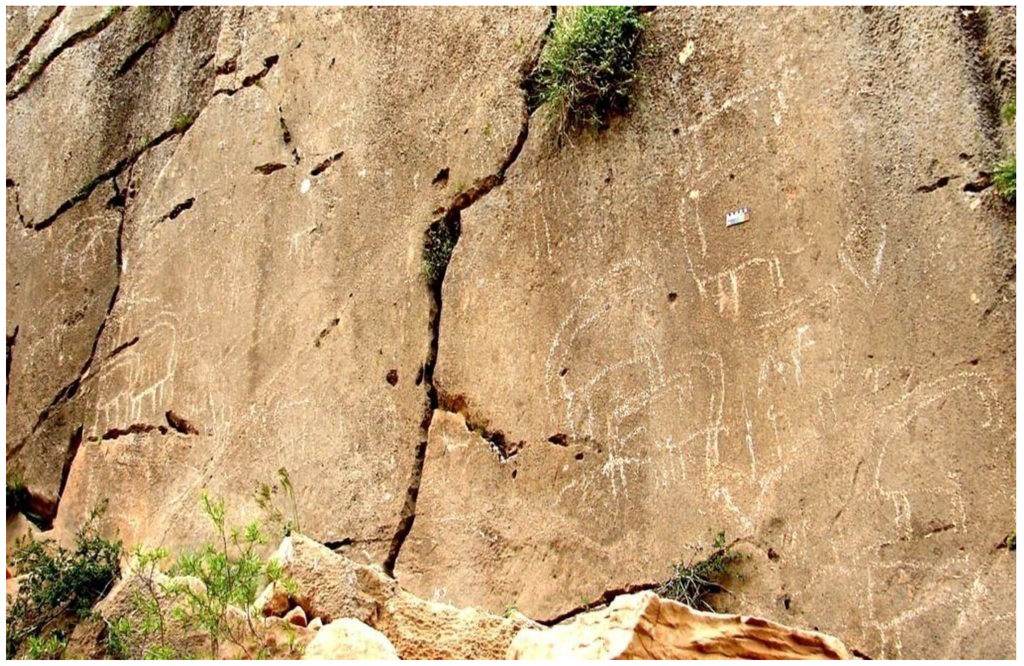
Figure 7.
“Antelopes” with long horns on Havar Poineh rock at Paveh.
2.3. The Petroglyphs in the West Part of Paveh
This one-meter cliff is located to the west of Paveh city in the highlands of the valley and its images include some anthropomorphs and geometric forms, but the pictures are barely visible (Figure 8). The geometric marks have been divided into four parts and they are similar to the circular geometric markings in Karaftoo Cave in Kurdistan.
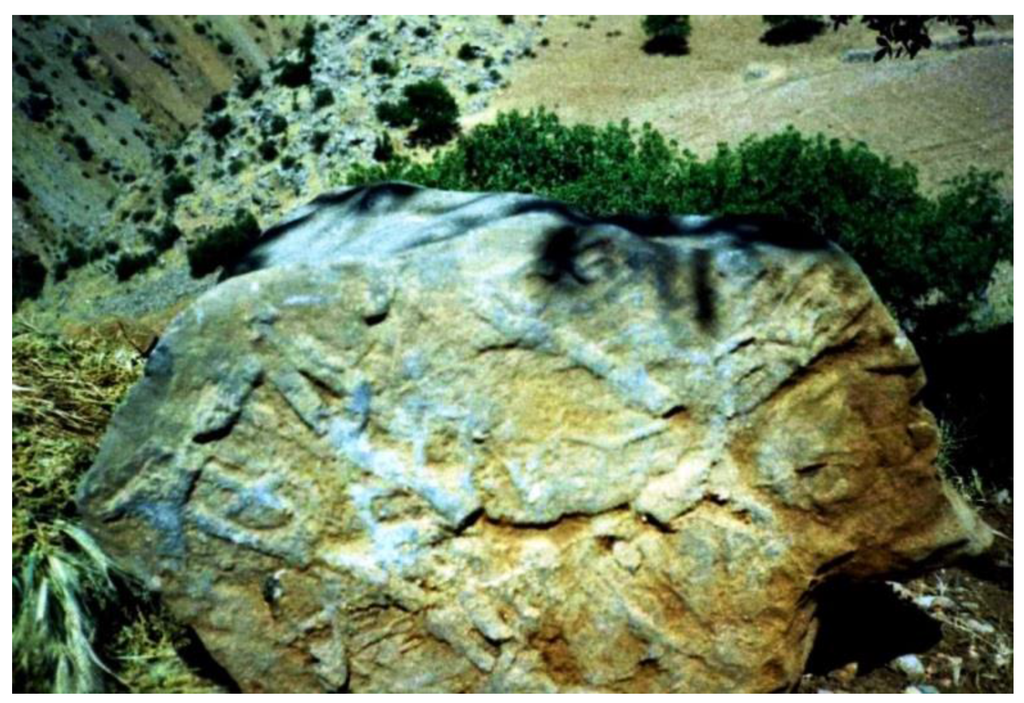
Figure 8.
A panel showing anthropomorphs and geometric markings, west of Paveh.
2.4. The Rock Art of Ryjab Village (Ryzhav)
The route from West Islamabad to Sarpol-e Zahab features a considerable number of rock art sites, but due to several reasons it was not possible to survey and identify the petroglyphs of these mountains and valleys, which show great potential. Therefore, the path to the valley north of the Ryzhav village, to the old mosque, was studied and several rock art sites were identified. On the way to the entrance of the valley to the right side of the vertical wall of the cliff (next to the electrical system and cables and at a height of 3 m above the ground), three old cupules have been made. Probably 30 years ago, many other cupules and other examples of rock art were obvious on the walls, which have been destroyed due to the construction of the electrical system and tourism facilities. These three cupules are the last examples of the ancient art in the entrance of valley. There are also four geometric shapes at a distance of a few centimeters from the earth level that are probably related to the Historical or Islamic era (Figure 9). The valley contains a considerable number of archaeological remains, which mostly have been dated to the Partian period [9].
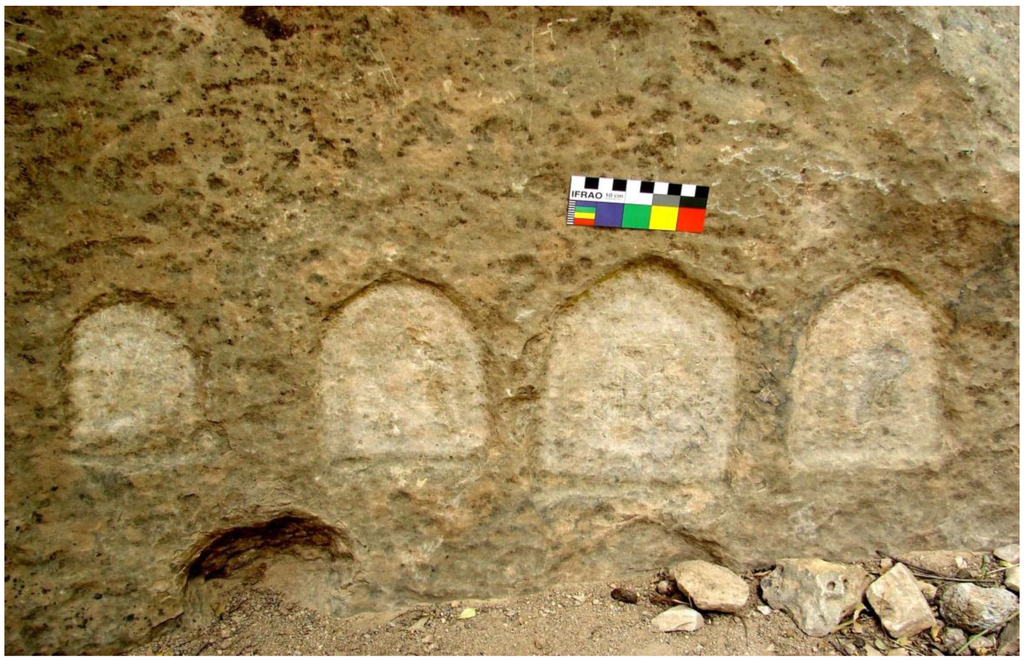
Figure 9.
Four small geometric shapes, which were probably made during Historic or Islamic periods.
In this valley, there is a picture of the same geometric figure engraved. Pieces of large stones and rocks occur in the entire valley to the old mosque. Much of the remains of a rural ancient dry-stone structure are also preserved in the valley. Stone mortars that were used to prepare food are abundant in this valley. Mortars have been carved on the horizontal surface of huge stones, individually and in groups. In one case, a mortar is located near a rectangular recess of 70 x 50 cm, which was used to store water. Mortars and water storage pits are not considered rock art [10]. As Bednarik says, there are many cupule-like features besides mortars [10]. Different interpretations have been proposed about cupules in different regions of the world. But the cupules with mortar shots have been discovered, as in some other area of Kurdistan [11] and the world [10]. The author suggests that the location of cupules in the same panel with mortars may show a conceptual relation with fertility purposes, possibly in order to wish abundance and bless for their foods [10]. However, ethnographic documents are required to support this interpretation. In this valley, three cupules between two mortars have been shown on the horizontal surface of the facade (Figure 10). One cupule and a mortar are also shown on the horizontal surface of a huge stone (Figure 11). On a horizontal surface of another cliff, there are two cupules occurring together (Figure 12).
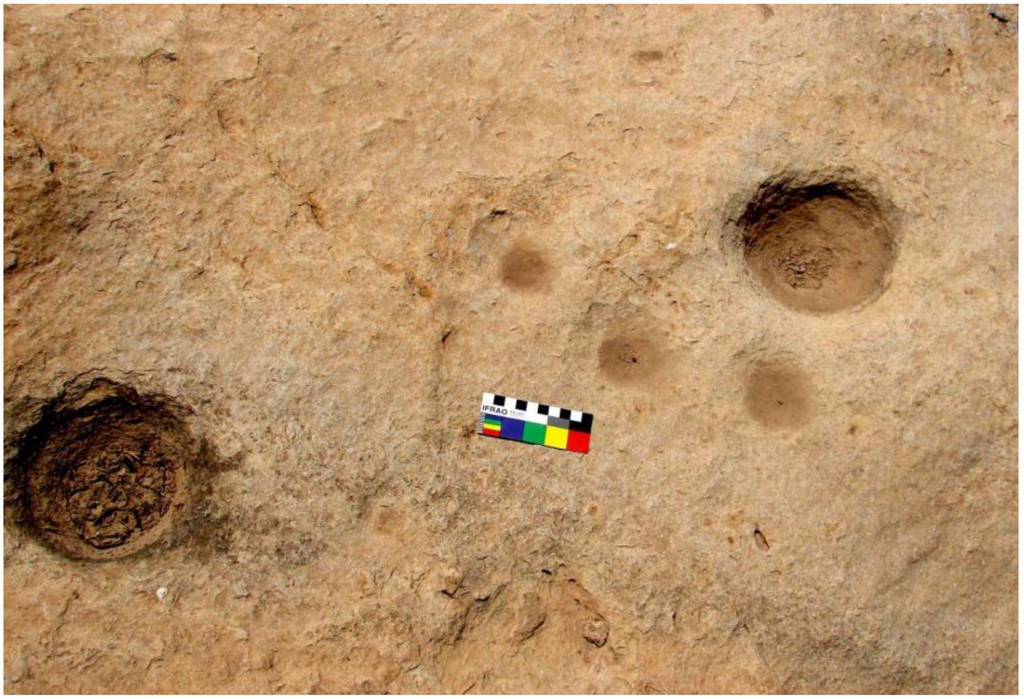
Figure 10.
Mortars and cupules in the rock art of Ryjab village.
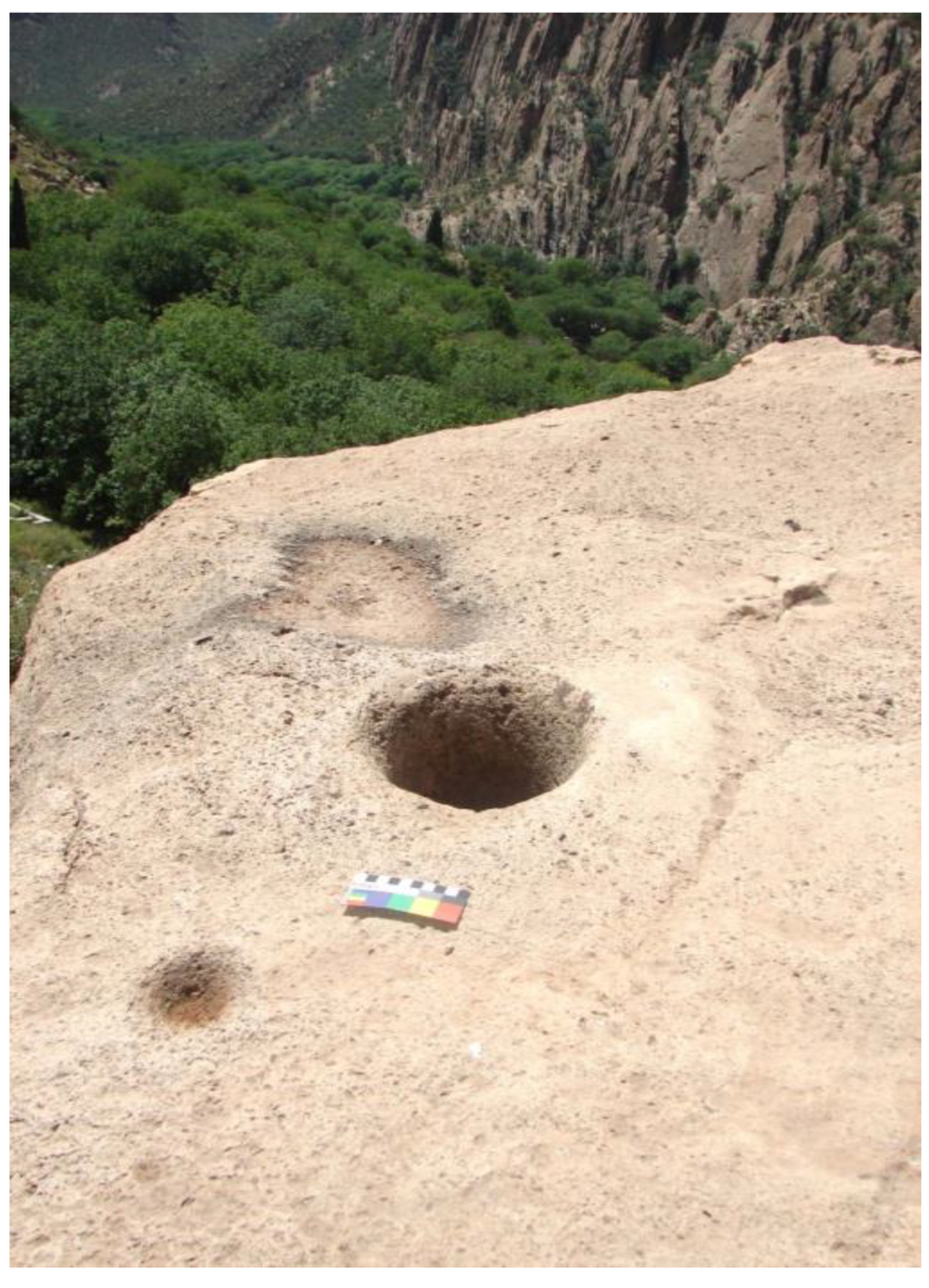
Figure 11.
On the horizontal surface of a huge cliff there are a cupule and a mortar.

Figure 12.
On the horizontal surface of a piece of huge stone, two cupules.
On the vertical surface of the rocks that make up the small sanctuary, rock art faces west. There is another panel, which shows two or three anthropomorphs and zoomorphs. The first anthropomorph on the right side of the group has been depicted embracing an ibex-resembling motif. Another “ibex” motif has also been depicted on the “skirt” or the body of the human shape. The second anthropomorph, possibly illustrates a female bearing a stick in hand. Another anthropomorph, perhaps depicts a child and a zoomorph, probably an “ibex”, are of the other depictions on the panel (Figure 13).
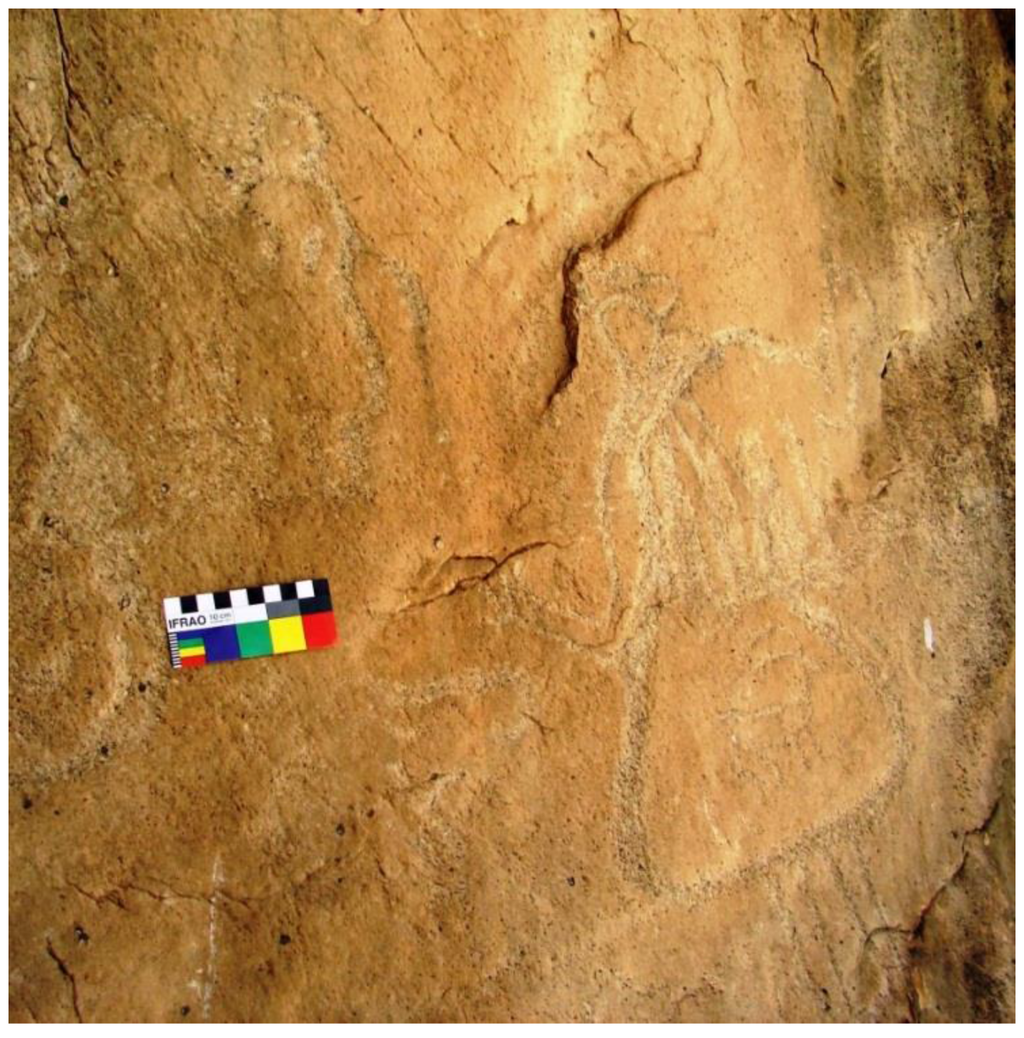
Figure 13.
Anthropomorphs and ibex-resembling depictions in the rock art of Ryjab village.
3. Conclusions
Extensive fieldwork by the author during recent years, in the western part of Kermanshah and especially different regions of Kurdistan, has identified many rock art sites in the areas that are unparalleled in the west of Iran and the Zagros Mountains. Kermanshah rock art has not been studied properly and identification of abundant sites of rock art in this area requires extensive future field studies. Dating is the most important difficulty concerning rock art studies in Kermanshah. Due to the lack of dating methods in Iran, traditional methods of dating, particularly iconography, has been used to suggest a primary chronology in numerous cases. In the case of rock art of the aforementioned sites, it is not possible to suggest a primary chronology using art style comparisons. The only possibility is that the “horse” depiction in Bi-Ravas are of the second millennium BCE or later, since horses were brought to Iran during this period [8]. Finally, establishing an organized research project is necessary in order to record and preserve rock art sites in the region.
Acknowledgments
I would like to thank Shojaa Naynava for translating this study from Persian to English; and also all the people who helped me perform the fieldwork.
Conflicts of Interest
The authors declare no conflict of interest.
References
- F. Biglari, and S. Shidrang. “The Lower Paleolithic Occupation of Iran.” Near Eastern Archaeol. 69 (2006): 160–168. [Google Scholar]
- M. Glozari. Kermanshah-Kurdistan (Asad Abad, Kangavar, Sahneh) 1. Tehran, Iran: Selseleh Entesharat, National Society of Iran, 1978. [Google Scholar]
- F. Biglari, A.M. Bisotuni, and F. Jamshidi. “The Pictograph of Cheshmeh Sohrab Cave (Mar Awaza), Dinwar Region, Kermanshah.” Persian J. Bastanpazhuhi 2 (2007): 50–54. [Google Scholar]
- S. Shidrang. “Maiwaleh Rock Arts; newly found engravings in the north of Kermanshah.” Persian J. Bastanpazhuhi 2 (2007): 55–60. [Google Scholar]
- J. Lahafian. The Report of Identifying the Oldest Petroglyphs of Iran in Kurdistan. Sanandaj, Iran: Cultural Heritage Organization of Iran, 1998, in press. [Google Scholar]
- J. Lahafian. “Rock Art in Kurdistan Iran.” Arts 2 (2013): 328–349. [Google Scholar] [CrossRef]
- J. Lahafian. “Petroglyphs of Kurdistan.” Rock Art Res. 20 (2004): 3–10. [Google Scholar]
- J. Makkay. “Horses. Nomads and Invasions from the Steppe from an Indo-European Perspective. Paper presented at the International Symposium, Archaeology of the steppes.” Dipartmentodi Studi Asiatici Istituto Universitario Orientale Series Minor 44 (1994): 149–166. [Google Scholar]
- E.J. Keall. “Qal’eh-i Yazdgerd. First season of excavations, 1975.” In Proceedings of the 4th Annual Symposium on Archaeological Research in Iran, Tehran, Iran, 1976; pp. 380–390.
- R.G. Bednarik. “Cupules.” Rock Art Res. 25 (2008): 66–100. [Google Scholar]
- J. Lahafian. “Cupules in Kurdistan rock art.” Rock Art Res. 27 (2010): 177–183. [Google Scholar]
© 2015 by the authors; licensee MDPI, Basel, Switzerland. This article is an open access article distributed under the terms and conditions of the Creative Commons Attribution license (http://creativecommons.org/licenses/by/4.0/).